Overcrowding Committee
At the request of the Battle Ground Public Schools Board of Directors and superintendent, a committee of 30 parents, staff and community members met over six weeks in the fall of 2018 to examine data and develop options to address overcrowding and continued growth in district schools.
The Overcrowding Committee presented its report, including several options for addressing overcrowding, to the Board of Directors at its meeting on Monday, Nov. 5:
Overcrowding Committee Report, Nov. 5, 2018 (PDF)
The Board thanked the committee for its concern for students, the sacrifices that individuals made to meet over several weeks, and the work that the group put into developing options.
Next steps:
- The Board of Directors will hold a work session on Nov. 19 to review the options and discuss considerations.
- Public forum(s) will be held to gather input.
- The Board will make a decision by January on how to address overcrowding in district schools.
The Issue
The district’s four southern schools—Glenwood Heights, Laurin, and Pleasant Valley Primary and Middle—are feeling the effects of significant growth. As of October 1, Glenwood (built for 484 students) had 810 students, while Laurin (built for 600) had 690 students. The Pleasant Valley campus (built for 993 students) had 1,090 students. An enrollment forecast conducted for the district by an economic development company projects Glenwood could increase by 380 to 445 students over the next 10 years, and Laurin by 380 to 440 students. The forecast projects that Pleasant Valley Primary could increase by 135 to 245 students and Pleasant Valley Middle by 80 to 170 students.
Committee Formation
Thirty people were chosen to serve on the committee. Members included 4 representatives from district office, 6 building principals, 6 staff members, 11 parents and 2 community members (one member had to resign). Staff members, parents and community members were selected from a pool of more than 50 applicants. Names were chosen by lottery. The process was supervised by School Board Members Tina Lambert (District 5) and Mavis Nickels (District 4) and witnessed by Superintendent Mark Ross. Names were placed into a container and drawn randomly.
The district hired Frances Portillo of Portillo Consulting International, to organize the process and facilitate meetings. Ms. Portillo is a facilitator, trainer and educational consultant who has worked with many districts throughout the Northwest and worldwide. Ms. Portillo helped assure an unbiased process where all committee members were encouraged to participate and share ideas.
Guiding Principles
During the first and second meetings, the committee developed a set of guiding principles. The purpose of these guiding principles was to be clear on the values and ethics that guided the committee through the process. The committee made sure that the options were true to the guiding principles that the committee had declared important.
- Student needs are the first priority. This includes student safety.
- Current learning spaces should be maximized.
- It is important to consider that all decisions made will impact the quality of student education for years to come.
- Equity (equal learning opportunities for all students) is important.
- Participation of all committee members and consideration of all perspectives is critical to effective problem solving.
- Recommendations will be supported by data and consider what is best for the district as a whole.
- Creativity and thinking out of the box is valued.
Central Question
Given that school-building resources will not be changing anytime soon, what can we do to best serve our students in the schools that we currently have available?
Goal
To come up with three to five recommendations for use of our schools to best serve our students.
The Central Question and Goal were articulated and posted at all meetings to keep focus on the task at hand. A copy of the Central Question and Goals was also included in committee members’ binders for reference when needed. The articulation and posting of the Central Question and Goal served as a reminder of what members were tasked to do and helped the committee to stay focused and consistent.
Data
The committee reviewed district data, including
- Battle Ground Enrollment Forecast Analysis, E.D. Hovee & Company, February 2018
- Enrollment and classroom use, October 2018
- Overcrowding Thoughtexchange Summary Report, September 2018
COMMITTEE MEMBERS
Options
The committee presented four options for the board to consider, and said it recognizes that the board may adjust the options based on additional facts and information. The committee requested the board recognize that:
- Boundary changes are hard. If the current situation remains, families, staff, and students will continue to feel the effects of overcrowding. If changes are made, families may be moved from their community schools and may have negative feelings about the proposed changes. We believe that given the circumstances, however, changes need to be made.
- It will be important during this time of transition for the district to listen to students and families impacted by changes. Providing support during the transition will be important to help students feel comfortable in their new schools. Changes to school boundaries can provide opportunities for students, families, and the community as a whole to learn lifelong lessons including adaptability, flexibility, and resilience.
Southern Shift
This option focuses on redistributing the students in the overcrowded southern schools to less crowded, neighboring facilities. Some students from Pleasant Valley and Glenwood/Laurin schools would shift to Tukes Valley schools, Daybreak schools, and Maple Grove K-8. This option contains three scenarios that are described in maps A, B & C.
Considerations:
- Student travel is minimized
- Allows for immediate reduction of students in the overcrowded schools but only provides for future growth in the Pleasant Valley primary and middle schools
- Boundary changes along major thoroughfares are clear and easy to understand
- Multiple scenarios for the Board to consider and/or modify based on student population and enrollment projections
- Maple Grove remains a K-8 school
K-4 Conversion
This option focuses on Maple Grove becoming a K-4 school with proposed boundary changes as per the map. Current Maple Grove 5-8 students would move to neighboring schools.
Considerations:
- Significantly relieves overcrowding at Glenwood Heights but does not reduce the population at Laurin Middle School or Pleasant Valley Schools
- Laurin would gain classroom space by using the Glenwood Heights 10-plexes that become available
- Creates a need for overlapping bus routes
- This option splits siblings between multiple campuses (Maple Grove)
- Allows Maple Grove K-8 to align with the other K-4 schools throughout the district
N.E.W. Boundaries
This option focuses on redrawing school boundaries by spreading students throughout the entire district. The district would be reorganized into north, east and west zones to take advantage of north/south transportation corridors. Boundary changes would occur at all primary and middle schools. High school boundaries would remain unchanged.
Considerations:
- Simplifies transportation by utilizing main arterials
- Provides balanced distribution of students while allowing for future growth at Pleasant Valley and Glenwood/Laurin Schools
- Considers enrollment projections and takes advantage of available space in ALL primary and middle schools across the district
- Maple Grove remains a K-8 school
- This option would impact the largest number of students
- Could lead to more requests for out of boundary exceptions
Move Out – Move In
This option focuses on utilizing Maple Grove to relieve pressure from Glenwood Heights Primary and Laurin Middle School. Students who currently attend Maple Grove would shift to Glenwood/Laurin, Daybreak and Tukes Valley Schools. Create a new school community out of the densely populated southeast corner of the district with a current student population of 594. Pleasant Valley will also be relieved of overcrowding pressure by shifting some students to Daybreak schools.
Considerations:
- Allows students in the neighborhood to remain together and creates “neighborhood school” in the area of the district most likely impacted by building of a new K-8 campus
- The school district currently owns a large piece of property slated for a future school in the area from which the students moved
- This option allows for future growth
- Most closely aligns with the district’s long-range facility plan
- Balances the student count across a large percentage of the district
- This option will impact a significant number of students
- Retains the K-8 model at Maple Grove
- Better utilization of newer, more secure schools
- The distance between students’ homes in the southeast and the school they attend (Maple Grove) would be 4.7+ miles
Final Thoughts
During the process of developing options, the committee identified concerns that were not applicable to the committee’s task of addressing overcrowding using current facilities:
- Members of the committee overwhelmingly support running a bond. They felt that all the proposed options were temporary given potential growth in the district according to the Hovee Report on enrollment growth.
- The committee suggests running smaller bonds targeting specific projects (e.g., building a new K-8 campus on property the district owns in the southeast). Timing and scope of the bond needs to be carefully considered. The committee recognizes that there is a significant population in the district that is averse to increased taxes, or that may not benefit from school improvements. Building relationships throughout the entire district will be necessary to pass a bond.
- Strong advocacy at the legislative level to eliminate the supermajority requirement for bond passage could be advantageous for the district. Advocacy at the local level to increase impact fees may increase funds to help mitigate overcrowding.
- Security and safety for children in our schools should be a primary concern. Newer buildings have security features available that are not possible to implement in the older schools.
- Relocation of Alternative Learning Experience (ALE) campuses would free up space for conventional schools.
- Ensuring that parents are aware of all alternative learning opportunities in the district, including River Online, may provide added relief to overcrowding while maintaining student funding within the district. Developing additional learning opportunities such as expanding the CASEE center or creating a magnet school (such as an Arts Academy or STEM school) should also be considered.
- As research in the field of K-12 education continues, the committee encourages district leaders and the board to stay informed of and implement best practices as they develop. The current model of K-4, 5-8, and 9-12 schools may want to be reconsidered in the future to best meet the developmental needs of students.










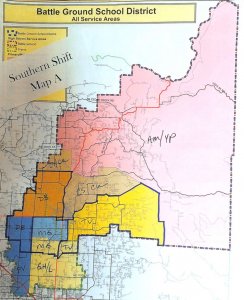
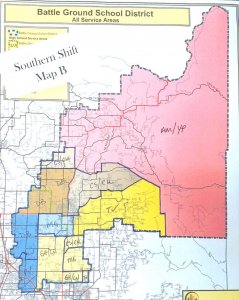
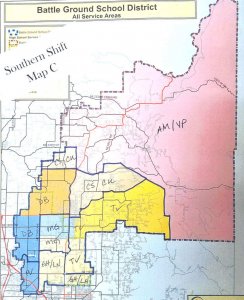
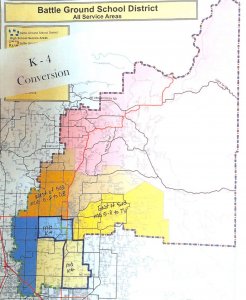
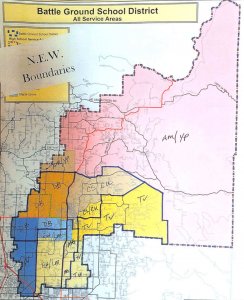
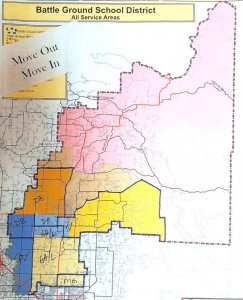
 11104 N.E. 149th Street,
11104 N.E. 149th Street,